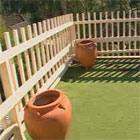Beverly Duncan wrote to Don asking for ideas on screening a very exposed deck. All the plants she had tried to grow there had died. Don thought that Beverly’s urn-shaped terracotta pots were part of the problem. Terracotta pots act like blotting paper, drawing water out of the soil. The water then evaporates and the plants dry out. Urn-shaped pots are also difficult to water properly.
Easy care solution
Lightweight fibreglass and cement composite troughs were installed in place of the terracotta urns. These are less porous and can hold a greater volume of soil than the urns, allowing the plants to grow taller and screen out the neighbours.
Drainage holes were drilled in the troughs. (Tip: when drilling the drainage holes wear safety gear, such as a mask and goggles).
The drainage holes were lined with fly wire to prevent the potting mix washing out, and the troughs were placed onto pot feet to elevate them off the deck. (Elevating the troughs facilitates drainage and prevents the decking from rotting out underneath.)
Don made sure that the troughs were level and then filled them with a premium grade potting mix for maximum water retention.
Oleanders were chosen to plant in the troughs, as they can cope with very tough conditions. To add much-needed colour and give the area a lift, Don selected a variety called ‘Ruby Embers’, which is known for its profusion of dusky, rose-pink flowers in late spring. (Note: like many other garden plants, oleanders are poisonous if eaten.) Oleanders do not have significant pest or disease problems and just need an occasional trim to keep them bushy and control their size.
After planting, Don fitted a double tap adaptor and new tap so Beverly still had use of a hose while being able to operate a fixed drip irrigation line to the troughs. The irrigation system consisted of a 19mm poly main line running from the tap, up behind the troughs and feeding into a 4mm spaghetti tube. 4mm dripline was then connected into the spaghetti tube with a 4mm T-connector and woven between the plants. The spaghetti tubing was held in place with wire pegs.
Further information
1500 x 400 x 400 polycrete (glass reinforced cement) troughs weigh about 60kg and cost about $319 each.
Stockists:
Decorator Terracota, Mona Vale Road, Terry Hills, NSW. PHone (02) 9450 1944
Quatro Design, 7/1 Wilfred Street, Billinudgel, NSW. Phone: (02) 6680 5500
Toppco Pty. Ltd., 140 Mooringe Avenue, North Plympton, S.A. PHone (08) 8295 5500, web: www.toppco.com.au
Cement pot feet cost $2.50 each at garden centres, nurseries and hardware stores.
Nerium oleander ‘Ruby Embers’ costs around $35 for a 250mm (10″) pot.
Ladco Add-A-Tap brass double tap adaptor costs about $10 (you’ll also need an extra brass tap for around $11) from hardware stores.
19mm polytube costs about $15 for a 25m roll with 4mm spaghetti tube, from irrigation specialists.



